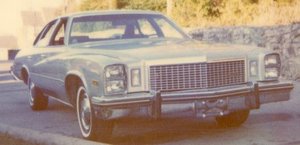Buick Century
|
|
Century is a model name used by Buick numerous times over a period of nearly 70 years. It usually was applied to a car in the middle of the Buick product range.
| Contents |
1936
The name was first used by the marque in 1936, positioned above the Special and below the Roadmaster and Limited. The Buick Century took the place of the Buick "60" Series. The basic formula for the 1936-1958 Buick Century was established by mating the smaller Buick Special bodies to the large block Buick eight cylinder engine. The Special was rated at (3200RPM) 233 C.I.D/93 H.P. to the Century's 320.2 C.I.D/120 H.P. earning the Century the nickname of the "banker's hotrod".
1954
Buick-century-57.jpg
The Century name disappeared when car production was discontinued part way through 1942, and did not re-emerge until 1954, running from then through 1958. In 1955, the California Highway Patrol placed a large fleet order for two door Century sedans, a body style unavailable to the general public. Perhaps the most notable model of the '50s was the Century Caballero, an unusual four-door hardtop station wagon which was produced for '57 and '58. Buick's 1959 complete line-up name changes retired the Century name for full-sized cars, replacing the 'most spirited Buick' with the Buick Invicta series.
1973
In 1973, when all GM's intermediate models were redesigned, the name reappeared on Buick's mid-size sedans and wagons and some coupes. (Previously the Skylark had been Buick's entry in this market segment.) From this point on, along with the new upmarket Regal coupe, Century was a mainstay of Buick's smaller line. With the vanishing of the Skylark coupe after '72, the Century inherited its potent Gran Sport performance option. While the Stage I 455 in³ (7.5 L) V8 was somewhat diminished from its performance heyday due to emission controls, the Century GS coupes of '73, '74, and '75 remained strong performers by the standards of the time. At the other end of the power spectrum, to meet fuel economy regulations, some later models of this generation were equipped with 231 in³ (3.8 L) V6's. (It should be noted that the Buick Centurion, which appeared about this same time, was a completely different car.)
1978
In 1978, a downsized, redesigned Century appeared in the form of a fastback coupe and a very unusual fastback sedan. V6's were standard due to fuel economy regulations. The fastback sedan did not sell well (in common with the similar Oldsmobile Cutlass Salon sedan) and it was revamped as a more conventional notchback in 1980.
1982
In 1982, another downsized Century arrived, this time on the front wheel drive GM A platform, in coupe, sedan, and wagon form. Wheelbase was 104.9 in, with 189 in overall length. Both four-cylinder and diesel V6 engines were offered in this generation, although neither became popular. Performance versions of several Buick models, including the Century coupe, were offered in the mid-80s under the T-Type name. With a 181 in³ (3.0 L) V6 producing 110 hp (82 kW), though, the T Century's performance was modest. This Century did gain an excellent reputation for build quality and reliability and had a very successful production run of 14 years.
Engines:
1989
The Century received a facelift for 1989 but continued on the aging GM A platform. Beginning in 1989, all models except wagons were easily known by their distinctive full-width tailights, a somewhat extravagant flourish on a smaller sedan, but one that carried on a Buick tradition of big tailights. An exterior refresh came in 1991. The 2.5 L I4 was replaced with a new 110 hp 2.2 L for 1993, and power on this engine was up to 120 hp for 1994 with the introduction of MFI. The 160 hp 3.3 L V6 was replaced with a 3.1 L V6 for 1994 with the same power rating.
Engines:
- 1990-1992 2500 2.5 L (151 in³) I4, 110 hp, 135 ft.lbf
- 1990-1993 3800 3.3 L (204 in³) V6, 160 hp, 185 ft.lbf
- 1993 2.2 L (134 in³) I4, 110 hp, 130 ft.lbf
- 1994-1995 2.2 L (134 in³) I4, 120 hp, 130 ft.lbf
- 1994-1995 3.1 3.1 L (191 in³) V6, 160 hp, 185 ft.lbf
1997
In 1997 what would prove to be the last Century appeared, still a front-drive V6 configuration, this time on the GM W platform. Only a four-door sedan was offered, the coupe and wagon variants having vanished. In this generation, the Century and Regal were exactly the same car, distinguished only by trim and powerplant differences. Since the Century was the lower-priced, it was also the lower-powered and plainer of the two. Nevertheless, the design was well-proportioned and the car retained its reputation for quality. After the 1998 discontinuation of the Skylark (which had returned as a compact in the ’80s), the Century for the first time became Buick's entry-level car.
Many late-model Buicks are difficult to distinguish from one another. The Century features a traditional Buick look with some chrome, while the Regal has a body-colored grille. This Century model also looks very similar to the larger LeSabre. Visual cues include the Century's rounder headlights and more angular grille.
Engines:
Future
From April 1999, Shanghai GM produced a version of this Century for the Chinese market. These models had slightly different names: the entry-level model was the Buick New Century, with more upscale models carrying the GL and GLX names. Later, G and GS models were added.
In 2004, it was announced that the all-new Buick LaCrosse would replace both Century and Regal in 2005. A limited run of Centuries with special trim was planned for model year 2005 to mark the end of the name.
External links
- Restoring a '37 Century coupe (http://homepages.together.net/~manycj/37buick.htm)
- Restoring a '41 Century sedanette (http://www.harwoodperformance.bizland.com/1941buick/)
- Muscle Car Club GS page (http://www.musclecarclub.com/musclecars/buick-gs/buick-gs-history.shtml)
- Century Indianapolis 500 Pace Car (http://www.mergetel.com/~lee/century/)
- Extensive 2003 Century review (http://popularmechanics.com/automotive/owners_reports/2003/2/buick_century_or/)
- Buick's official page (http://www.buick.com)

